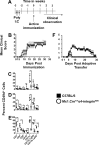TLR3 agonism re-establishes CNS immune competence during α 4-integrin deficiency
- PMID: 30564621
- PMCID: PMC6292184
- DOI: 10.1002/acn3.664
TLR3 agonism re-establishes CNS immune competence during α 4-integrin deficiency
Abstract
Objective: Natalizumab blocks α4-integrin-mediated leukocyte migration into the central nervous system (CNS). It diminishes disease activity in multiple sclerosis (MS), but carries a high risk of progressive multifocal encephalopathy (PML), an opportunistic infection with JV virus that may be prompted by diminished CNS immune surveillance. The initial host response to viral infections entails the synthesis of type I interferons (IFN) upon engagement of TLR3 receptors. We hypothesized that TLR3 agonism reestablishes CNS immune competence in the setting of α4-integrin deficiency.
Method: We generated the conditional knock out mouse strain Mx1.Cre+ α4-integrinfl/fl, in which the α4-integrin gene is ablated upon treatment with the TLR3 agonist poly I:C. Adoptive transfer of purified lymphocytes from poly I:C-treated Mx1.Cre+ α4-integrinfl/fl donors into naive recipients recapitulates immunosuppression under natalizumab. Active experimental autoimmune encephalomyelitis (EAE) in Mx1.Cre+ α4-integrinfl/fl mice treated with poly I:C represents immune-reconstitution.
Results: Adoptive transfer of T cells from poly I:C treated Mx1.Cre+ α4-integrinfl/fl mice causes minimal EAE. The in vitro migratory capability of CD45+ splenocytes from these mice is reduced. In contrast, actively-induced EAE after poly I:C treatment results in full disease susceptibility of Mx1.Cre+ α4-integrinfl/fl mice, and the number and composition of CNS leukocytes is similar to controls. Extravasation of Evans Blue indicates a compromised blood-brain barrier. Poly I:C treatment results in a 2-fold increase in IFN β transcription in the spinal cord.
Interpretation: Our data suggest that TLR3 agonism in the setting of relative α4-integrin deficiency can reestablish CNS immune surveillance in an experimental model. This pathway may present a feasible treatment strategy to treat and prevent PML under natalizumab therapy and should be considered for further experimental evaluation in a controlled setting.
Figures







Similar articles
-
CD11c+CD88+CD317+ myeloid cells are critical mediators of persistent CNS autoimmunity.Proc Natl Acad Sci U S A. 2021 Apr 6;118(14):e2014492118. doi: 10.1073/pnas.2014492118. Proc Natl Acad Sci U S A. 2021. PMID: 33785592 Free PMC article.
-
α4-integrin deficiency in B cells does not affect disease in a T-cell-mediated EAE disease model.Neurol Neuroimmunol Neuroinflamm. 2019 Apr 16;6(4):e563. doi: 10.1212/NXI.0000000000000563. eCollection 2019 Jul. Neurol Neuroimmunol Neuroinflamm. 2019. PMID: 31086806 Free PMC article.
-
Th17 lymphocytes traffic to the central nervous system independently of α4 integrin expression during EAE.J Exp Med. 2011 Nov 21;208(12):2465-76. doi: 10.1084/jem.20110434. Epub 2011 Oct 24. J Exp Med. 2011. PMID: 22025301 Free PMC article.
-
The role of alpha-4 integrin in the aetiology of multiple sclerosis: current knowledge and therapeutic implications.CNS Drugs. 2005;19(11):909-22. doi: 10.2165/00023210-200519110-00002. CNS Drugs. 2005. PMID: 16268663 Review.
-
Novel treatment options for inflammatory bowel disease: targeting alpha 4 integrin.Drugs. 2006;66(9):1179-89. doi: 10.2165/00003495-200666090-00002. Drugs. 2006. PMID: 16827596 Review.
Cited by
-
Distinctive transcriptomic and epigenomic signatures of bone marrow-derived myeloid cells and microglia in CNS autoimmunity.Proc Natl Acad Sci U S A. 2023 Feb 7;120(6):e2212696120. doi: 10.1073/pnas.2212696120. Epub 2023 Feb 2. Proc Natl Acad Sci U S A. 2023. PMID: 36730207 Free PMC article.
-
CNS Resident Innate Immune Cells: Guardians of CNS Homeostasis.Int J Mol Sci. 2024 Apr 29;25(9):4865. doi: 10.3390/ijms25094865. Int J Mol Sci. 2024. PMID: 38732082 Free PMC article. Review.
-
CD11c+CD88+CD317+ myeloid cells are critical mediators of persistent CNS autoimmunity.Proc Natl Acad Sci U S A. 2021 Apr 6;118(14):e2014492118. doi: 10.1073/pnas.2014492118. Proc Natl Acad Sci U S A. 2021. PMID: 33785592 Free PMC article.
-
The antioxidant MnTBAP does not effectively downregulate CD4 expression in T cells in vivo.J Neuroimmunol. 2021 May 15;354:577544. doi: 10.1016/j.jneuroim.2021.577544. Epub 2021 Mar 8. J Neuroimmunol. 2021. PMID: 33756414 Free PMC article.
-
Role of Toll-Like Receptors in Neuroimmune Diseases: Therapeutic Targets and Problems.Front Immunol. 2021 Nov 1;12:777606. doi: 10.3389/fimmu.2021.777606. eCollection 2021. Front Immunol. 2021. PMID: 34790205 Free PMC article. Review.
References
-
- Stuve O, Zamvil SS. Neurologic diseases In: Parslow TG, Stites DP, Terr AI, Imboden JB, eds. Medical Immunology. San Francisco: McGraw Hill, 2001:510–526.
-
- Yednock TA, Cannon C, Fritz LC, et al. Prevention of experimental autoimmune encephalomyelitis by antibodies against alpha 4 beta 1 integrin. Nature 1992;356:63–66. - PubMed
-
- Stuve O, Marra CM, Jerome KR, et al. Immune surveillance in multiple sclerosis patients treated with natalizumab. Ann Neurol 2006;59:743–747. - PubMed
-
- Stuve O, Marra CM, Bar‐Or A, et al. Altered CD4+/CD8+ T‐cell ratios in cerebrospinal fluid of natalizumab‐treated patients with multiple sclerosis. Arch Neurol 2006;63:1383–1387. - PubMed
Grants and funding
LinkOut - more resources
Full Text Sources
Research Materials
Miscellaneous

